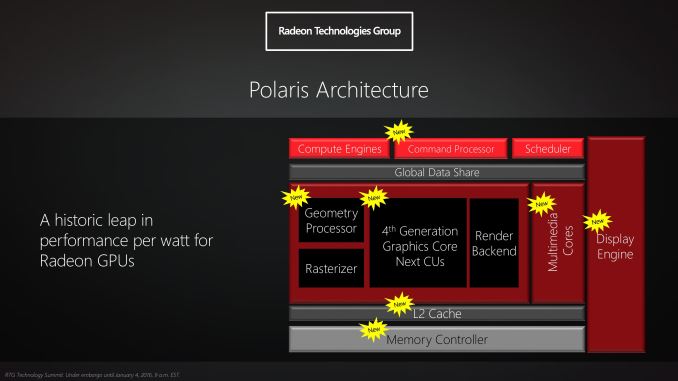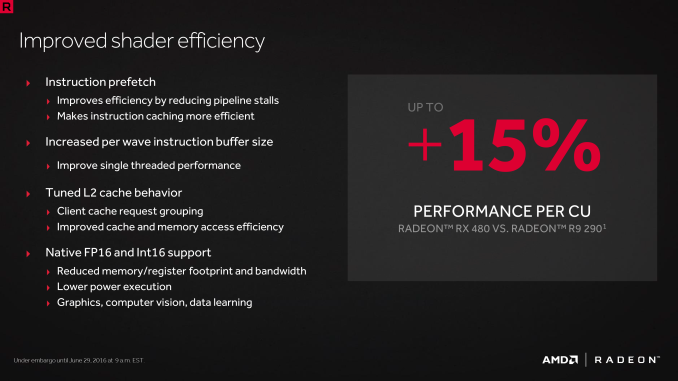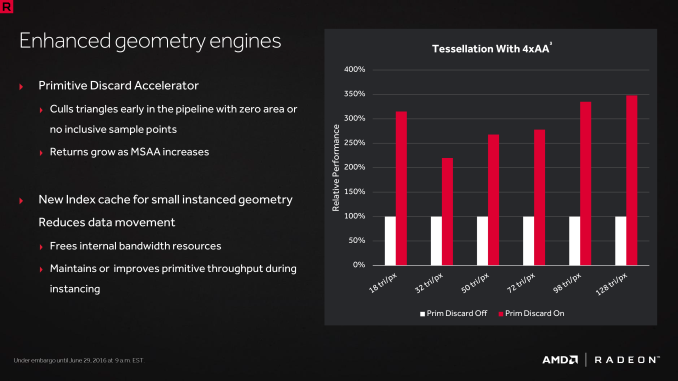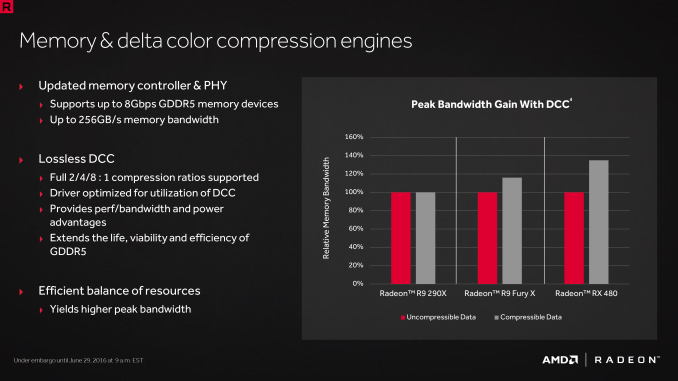The AMD Radeon RX 480 Preview: Polaris Makes Its Mainstream Mark
by Ryan Smith on June 29, 2016 9:00 AM ESTThe Polaris Architecture: In Brief
For today’s preview I’m going to quickly hit the highlights of the Polaris architecture.
In their announcement of the architecture this year, AMD laid out a basic overview of what components of the GPU would see major updates with Polaris. Polaris is not a complete overhaul of past AMD designs, but AMD has combined targeted performance upgrades with a chip-wide energy efficiency upgrade. As a result Polaris is a mix of old and new, and a lot more efficient in the process.
At its heart, Polaris is based on AMD’s 4th generation Graphics Core Next architecture (GCN 4). GCN 4 is not significantly different than GCN 1.2 (Tonga/Fiji), and in fact GCN 4’s ISA is identical to that of GCN 1.2’s. So everything we see here today comes not from broad, architectural changes, but from low-level microarchitectural changes that improve how instructions execute under the hood.
Overall AMD is claiming that GCN 4 (via RX 480) offers a 15% improvement in shader efficiency over GCN 1.1 (R9 290). This comes from two changes; instruction prefetching and a larger instruction buffer. In the case of the former, GCN 4 can, with the driver’s assistance, attempt to pre-fetch future instructions, something GCN 1.x could not do. When done correctly, this reduces/eliminates the need for a wave to stall to wait on an instruction fetch, keeping the CU fed and active more often. Meanwhile the per-wave instruction buffer (which is separate from the register file) has been increased from 12 DWORDs to 16 DWORDs, allowing more instructions to be buffered and, according to AMD, improving single-threaded performance.
Outside of the shader cores themselves, AMD has also made enhancements to the graphics front-end for Polaris. AMD’s latest architecture integrates what AMD calls a Primative Discard Accelerator. True to its name, the job of the discard accelerator is to remove (cull) triangles that are too small to be used, and to do so early enough in the rendering pipeline that the rest of the GPU is spared from having to deal with these unnecessary triangles. Degenerate triangles are culled before they even hit the vertex shader, while small triangles culled a bit later, after the vertex shader but before they hit the rasterizer. There’s no visual quality impact to this (only triangles that can’t be seen/rendered are culled), and as claimed by AMD, the benefits of the discard accelerator increase with MSAA levels, as MSAA otherwise exacerbates the small triangle problem.
Along these lines, Polaris also implements a new index cache, again meant to improve geometry performance. The index cache is designed specifically to accelerate geometry instancing performance, allowing small instanced geometry to stay close by in the cache, avoiding the power and bandwidth costs of shuffling this data around to other caches and VRAM.
Finally, at the back-end of the GPU, the ROP/L2/Memory controller partitions have also received their own updates. Chief among these is that Polaris implements the next generation of AMD’s delta color compression technology, which uses pattern matching to reduce the size and resulting memory bandwidth needs of frame buffers and render targets. As a result of this compression, color compression results in a de facto increase in available memory bandwidth and decrease in power consumption, at least so long as buffer is compressible. With Polaris, AMD supports a larger pattern library to better compress more buffers more often, improving on GCN 1.2 color compression by around 17%.
Otherwise we’ve already covered the increased L2 cache size, which is now at 2MB. Paired with this is AMD’s latest generation memory controller, which can now officially go to 8Gbps, and even a bit more than that when oveclocking.














449 Comments
View All Comments
Badelhas - Thursday, June 30, 2016 - link
No Virtual Reality benchmarks? This doesn't sound like AnandTech. That's the main reason I am interested in gpu's nowadays. What a disappointment...T1beriu - Thursday, June 30, 2016 - link
As you can read in the headline, this was a PREVIEW.Ryan Smith - Friday, July 1, 2016 - link
The VR benchmarking situation is currently poor. I'll have something for the full review, but we don't have any good VR benchmarks like we do standard displays. VR Mark and VRScore should be released soon.IntoGraphics - Thursday, June 30, 2016 - link
Any MXGP2 players here?What are your thoughts about RX 480 8GB playing MXGP2 at 1440p@60fps?
Recommended GPUs are GTX 970 and R9 390. But this video shows a GTX 970 in-game already at 100% at 1080p with maxed out settings.
I'm assembling an X99 based PC. i7-6800K, 32GB 3200MHz DDR4.
IntoGraphics - Thursday, June 30, 2016 - link
Link to the vid : https://youtu.be/e8y3IR-7YIUD. Lister - Thursday, June 30, 2016 - link
You're "into graphics", yet instead of going for a "mid-end CPU/mid-end GPU" combo, you would rather go for "high-end CPU/Low-end GPU"? If e.g., you went instead with an i5/1070, you would probably be able to down-sample from 3K to 1440p and still have a locked 60FPS.fanofanand - Thursday, June 30, 2016 - link
He is trying to get "followers" for his youtube channel. Don't even click the link or you will drive up his view count, which will only encourage him to spam comments with more links to his video.D. Lister - Thursday, June 30, 2016 - link
No worries, I never click on random forum links, unless it is porn, lol. Just kidding.IntoGraphics - Thursday, June 30, 2016 - link
Are the reference RX 480 cards going up to other reference cards in this comparison?Or were some or all of their competitors equipped with aftermarket coolers and factory overclock?
What was compared here?
sparrowkhx - Thursday, June 30, 2016 - link
AMD hype again, 2 RX 480s probably beat a single 1070 while consuming twice the power and ultimately being a similar cost... They definitely aren't going to beat a 1080 and I'm even more glad that I purchased an EVGA 1070 FTW for 429.Additionally, I haven't been on Anandtech since the 1080 preview, seriously what is the deal with all these previews and missing reviews? I'm more interested in reading the reviews than random articles and other places are actually doing full reviews not previews.